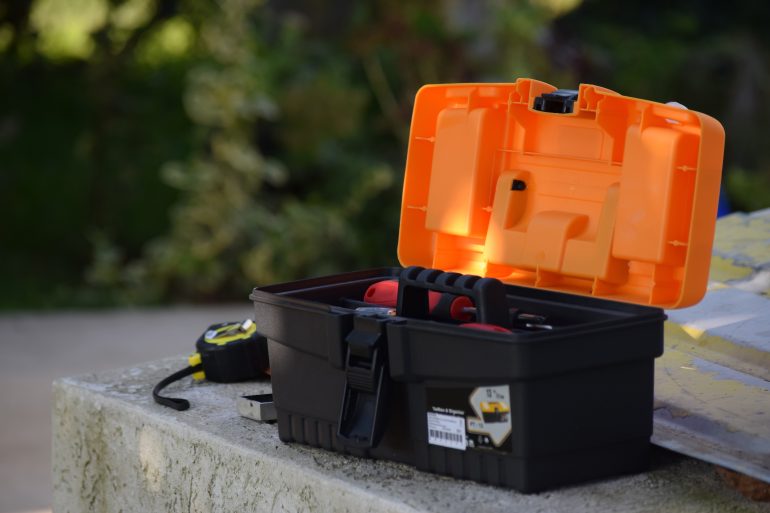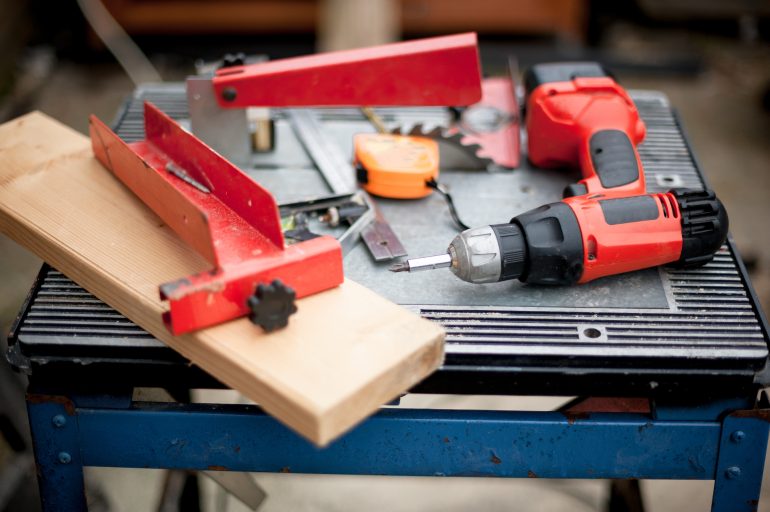Keeping your home in tip-top condition is a never-ending job, but what tools do you need to get started as a DIY-er?
If your shopping list simply says ‘tools’ and you walk into one of the cavernous hardware stores, you can get overwhelmed with the sheer choice on offer. Luckily, that’s where we come in. We’ll give you the names of DIY tools as well as an essential DIY power tools list.
Choose the right tools and you’ll do a good job, but what should be on your DIY tools list? There are some you’ll need occasionally, and some you’ll use over and over for years. Here is our essential home DIY tools list.
Start At The Very Beginning

A toolbox (Photo: Elena Pejchinova via Getty Images)
This may be stating the obvious but the first thing at the top of your DIY tools list should be a sturdy toolbox. You can get them in metal or hard plastic and, if you’re looking to buy a new one, look for one with deep storage and smaller organisers for things like nails and screws. An old sports bag isn’t very practical and keeping everything in a drawer is annoying if you need to keep going back and forth to get the tools you need.
The Basics

Collection of Tools (Photo: MirageC via Getty Images)
These are the tools every household needs to do the basic tasks. With this essential home DIY tools list, you can fix just about anything. Start with a tape measure, a pack of pencils, a few rolls of duct, electrical and masking tape and a torch and you’re good to go. In addition, depending on what sort of DIY-er you want to become, a tool belt and a good portable step ladder are great things to have at hand should you need them.
Screwdriver Set
A standard 10-piece set will usually come with five flathead screwdrivers and five Phillips screwdrivers in the most common sizes. On the subject of the names of DIY tools, did you know the Phillips screwdriver is named after an American businessman called Henry F. Phillips? He refined the design of the cross-head screw and the screwdriver to go with it. It was primarily adopted by car manufacturers who needed a screw with more torque to hold body parts tightly together.
Hammer
There are two or three types of hammer to consider. The first is a classic claw hammer with one end designed to drive in nails and the other to remove them. The second is a lump hammer used for breaking materials or driving fence posts into the ground, and the third is a mallet which is used for striking without damaging surfaces or materials.
Knife
A retractable knife is a very useful multipurpose item which should be on your DIY tools list. It’s got a multitude of uses and it will be in and out of your toolbox time and time again. Opening boxes, marking cut points and a host of other crucial tasks are just a few of the reasons why a retractable knife is a good idea.
Saws
Saws are also very useful and are used for lots of jobs around the house. A standard hand saw should be in your toolbox (ensure it has a protective cover), and it may be worth buying a smaller hand saw or a coping saw with additional blades for more intricate jobs.
Allen Keys
These are the flat-pack furniture builder’s tool of choice. Usually the furniture comes with one but it’s worth getting a set. You’ll be surprised how many household jobs require an allen key to tighten up or loosen. They’re often called hex keys as they’re hexagonal but – like the Phillips screwdriver – the names of DIY tools are often quite interesting. Allen keys, or more accurately, Allen wrenches, are named after the Allen Manufacturing Company from Connecticut. Hexagonal-shaped wrenches had been around since the nineteenth century but AMC patented them in 1910 and they’ve been known as Allen keys ever since.
Spirit Level
If you’re looking for the best DIY tools and ideas to fill your toolbox, a spirit level is a great shout. Gallery walls, shelves, pictures and patios will be perfectly straight rather than the subject of confused looks from visitors.
Adjustable & Fixed-Sized Wrenches
An adjustable wrench gives you the flexibility you need, but a lot of jobs do require specific-sized wrenches so it’s worth getting both to complement each other.
Pliers
You’ll get your money’s worth from a good set of pliers. Most sets come with three or four including tongue-and-groove, diagonal cutters, long-nose pliers and a slip joint version. These should definitely be on the essential home DIY tools list.
DIY Power Tools List

Power tools (Photo: Tim Grist Photography via Getty Images)
A good selection of power tools is a boost for any toolbox, and they allow you to complete home improvement projects in confidence. It really does depend on what you’re looking to do – many places hire power tools for occasional use – but this DIY power tools list is a great place to start.
Cordless Drill
This is one of the potential ‘must haves’ for any DIY-er. It’s an incredibly versatile tool and you can even put your screwdriver heads into the aperture – known as a chuck – for troublesome screws that refuse to budge by muscle power alone. If you do get a cordless drill, make sure you get a good set of drill bits for the jobs you want to do, including woodwork and masonry.
Electric Screwdriver
These are perfect for flat-pack furniture enthusiasts and lighter tasks that don’t require the power of a drill.
Circular Saw
This is an essential tool for experienced woodworkers. It’s high-powered yet controlled and you can cut straight, clean lines through timber. There are other, tougher blades available for cutting through metal, masonry and mortar.
Electric Planer
Another great tool for those experienced DIY-ers working primarily with wood, an electric planer takes the stress out of using a manual planer to get the best finish. These power tools are a great starting point when crossing off things to buy on your DIY power tools list. And as you progress through your journey, there are lots of other tools to consider including a jigsaw, orbital sander, mitre saw, nail gun and lots more.
These are the must-have items for every toolbox. There will always be a tool for whatever you need to do, you just need to find it!












